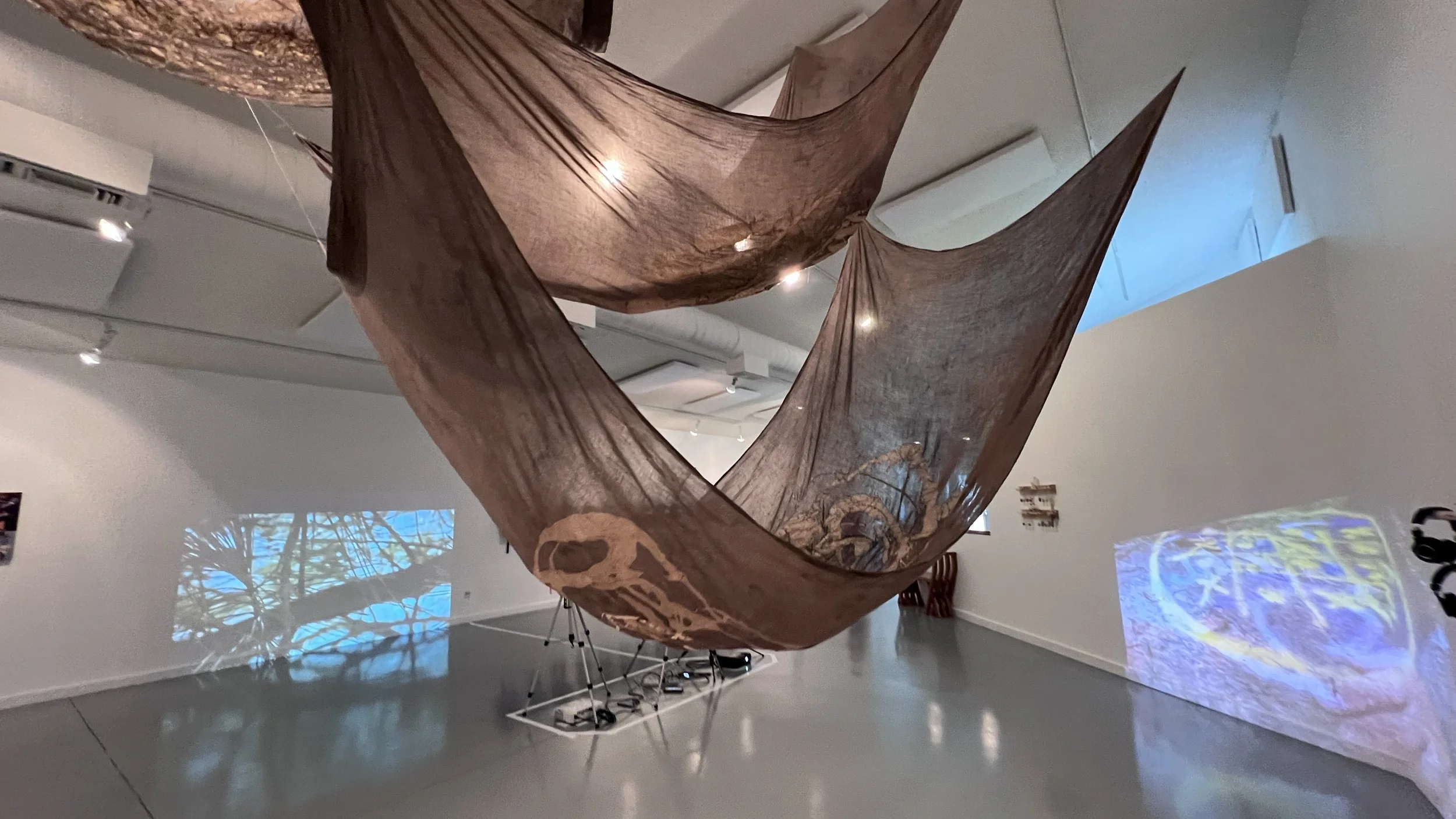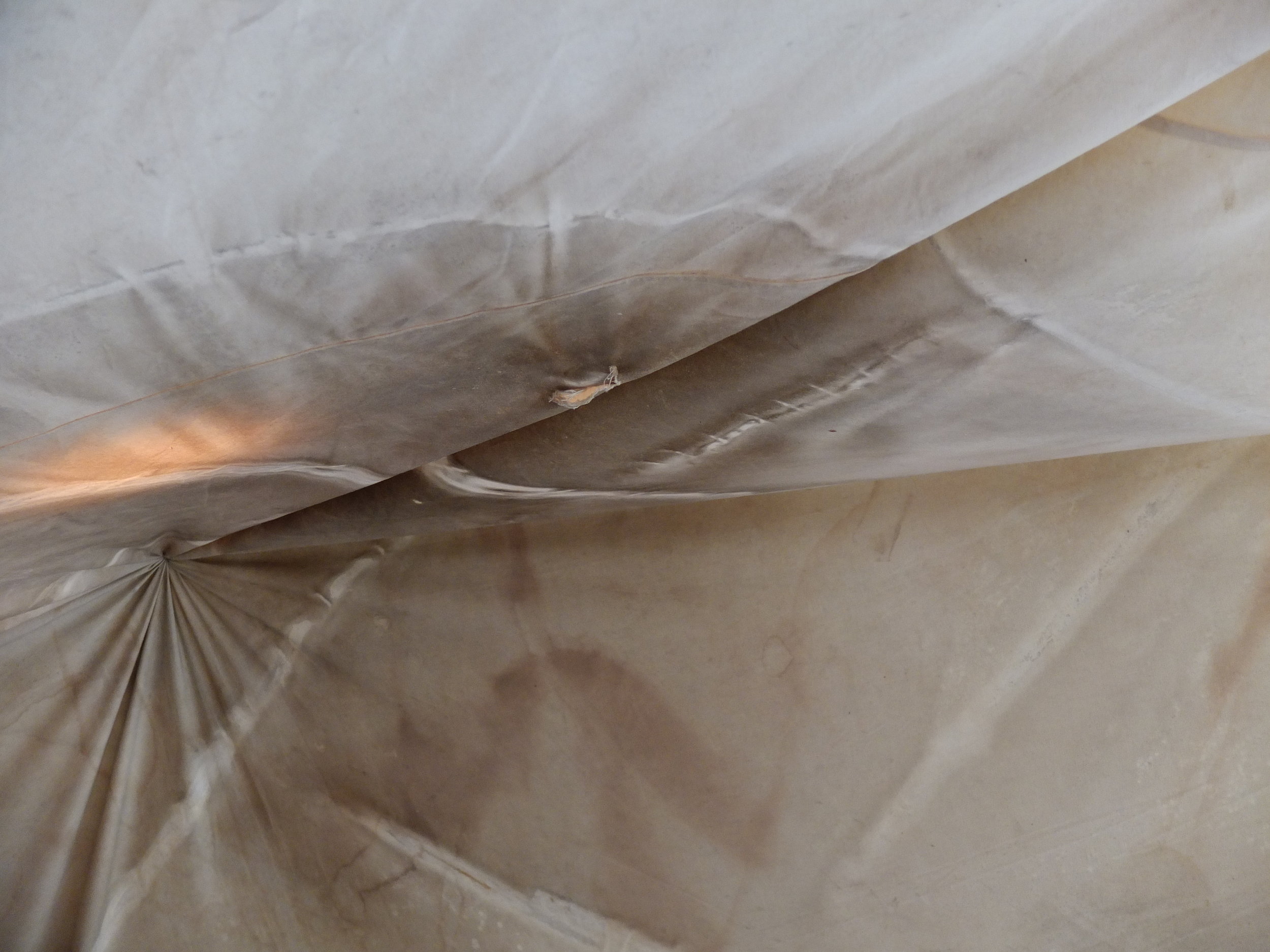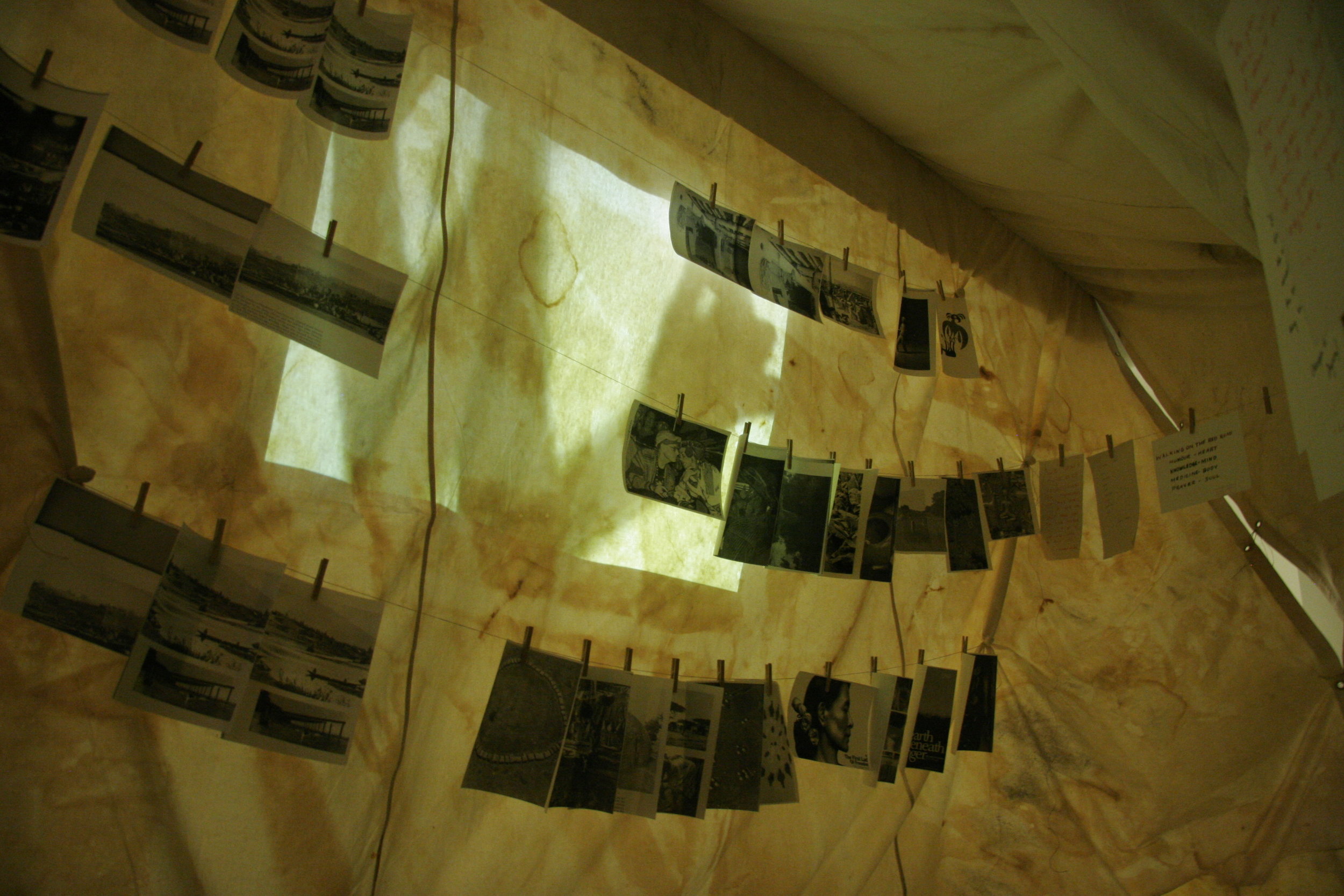about
bio
23/10/23
ee portal (Elyse & Emilio Portal) is a collective of mixed ancestry currently based within the Robinson Huron Treaty of 1850 territory of the Atikameksheng Anishnawbek (descendents of the Ojibwe, Algonquin and Odawa Nations). Emilio Portal is Peruvian (Indigenous, Spanish, West & Central African diaspora), French, and Irish. His transdisciplinary practice, rooted in ecological philosophy, craft, design-build, and architecture, feels most connected to humans and more-than-humans through sound art and engineering enlivened by chance, randomness and anarchic methods. Elyse Portal is a settler of Ukrainian, Baltic, Mennonite, German, Scandinavian and Irish heritage. Her work revolves around climate crisis endurance exercises that include pigment foraging, climate narratives painted with natural pigments in walnut oil, installation, social practice, video, performance, and bioremedial art. ee portal offers a third space to collectively exchange, stimulate, coalesce, and bring diverse skills and perspectives into issues that are massively intangible, such as the Anthropocene and the 6th Mass Extinction.
In 2011, ee portal initiated their collaboration with the multidisciplinary work, “advanced life support unit,” at the University of Victoria. As part of the installation we deconstructed the space, removed the gallery door, and projected “shadow,” a video that documented the movements of a woman who was told she would never move her body again after a severe spinal cord injury. In the face of great adversity, she slowly regained access to her body through somatic therapy. ee portal are continually motivated by the courage of this woman to recover her body - piece by piece, starting with the smallest actions.
climate crisis endurance exercises are small actions we take in ecological material research by reaching out to artists like John Sabraw, who had the curiosity to ask: does this contaminated red river, from Acid Mining Drainage, hold pigments that could be non-toxic? Sabraw has gone on to answer that question, generating non-toxic reclaimed pigments sold through Gamblin. His numerous small actions are now gaining enthusiasm and funding across sectors so he can scale his project to both gather the pigments and remediate the industrially contaminated watershed in Truetown, Ohio. Bioremedial artists, such as Sabraw, Aviva Rahmani and others are actively working with us as mentors and muse.
Ecological philosophy, such as the work of Timothy Morton, with a specific focus on more-than-human relations, is central to ee portal’s creative practice, including our summer residency at the Burren College of Art, County Clare, Ireland; following, the subsequent body of work, mnemonic for the commons, was funded by the Canada Council for the Arts, and exhibited at Debaser (Ottawa), festivals across Ontario, and for online audiences around the world. mnemonic for the commons was premised on the ethic that all entities, whether human, nonhuman, animate, or inanimate, were inherently and innately valuable. Objects/sounds/concepts that were seen as detritus (in all its various meanings, including the often hidden or stolen relief sculptures of Sheela na gigs) were offered space through visuals and sound. mnemonic for the commons was exhibited widely, including at the Burren College of Art’s Newtown Castle with intuitive, improvised performances of field recordings from the Burren and randomised synthesiser sequences.
In the summer heat of the pandemic (2021), ee portal produced blueberry entanglements for Sudbury’s Cooling Shelter; here, unhoused people participated in a video, sound, and redistribution interarts installation. Myths and Mirrors, has been a touchstone for ee portal in the context of Northern Ontario, with its focus on the interrelatedness of social justice issues and ecological crises. We are continually working with them as artists or as part of their board to uplift marginalised, underrepresented, and vulnerable communities: notably through outreach with those affected by homelessness and substance abuse in the downtown core, while fostering partnerships with Black Lives Matter, and encouraging increased representation of Indigenous and LGBTQ2S+ individuals/communities through hiring processes and their BIPOC mentorship program.
With Myths and Mirrors, the Coalition for a Livable Sudbury, and ReThink Green, ee portal produced a submission for the McEwen School of Architecture Sudbury 2050 design challenge to reimagine the city of Sudbury in a rapidly changing global environment. Our project, Mashkikike, was grounded in grassroots community priorities with a seed vision from 1000 citizens that envisioned downtown as a place of healing for all. We were guided by 5 themes: decolonialism, ecological resilience, net zero, care and vibrancy. Submissions were international. Our design team received Honourable Mention (2nd place), along with the following comment from a jury member:
“I think this is so important what you are proposing here, because at an urban scale, there’s a risk of us just continuing urbanism-as-usual, like business-as-usual, and if we really want to make a serious attempt in our country to heal, as you’ve framed it in this proposal, it needs exactly the kind of collective thinking, and respect of the language and the land that you’ve proposed. (…) I’m completely sold. What I love about it is the inclusivity of it. I feel it’s really of the place. I think that your grassroots approach to it really stands out as something unique to this competition. I really, really commend everything that you’ve done.”
— Dr. David Fortin, Director of the McEwen School of Architecture, Laurentian University
Arts that open up channels to feel place, through research, sound, video, design, pigment, material, performance and community engagement, are at the heart of ee portal. The recent exhibition art environment life everything (Durham Art Gallery, 2023) combined these methodologies, and has led to a new research proposal called, Poetics of Regreening Porous Skins. This project dives into the impacts of PFAs in Northern Ontario, and also considers Jane Goodall’s recent film Reasons for Hope in the context of Sudbury’s regreening project, and unaccounted mass tailings (especially as we transition to nickel battery electrified energy). Here, we will be working with numerous artists from the internationally renowned ecological artist, John Sabraw, to Northern Ontario’s Anishnaabek (from Wikwemikong) B-Boy Curtis Kagige. We have been given permission to present this work within the context of Manidoo Bineshii Dreams on Atikameksheng Anishnawbek First Nation.
…
13/07/2019
In 2011, ee portal (Elyse & Emilio Portal) initiated their collaboration with the multidisciplinary work, advanced life support unit, at the University of Victoria. As part of the installation the duo deconstructed the space, removing the the gallery door to project shadow, a video that documents the movements of a woman (and friend) who was told she would never move her body again after a severe spinal cord injury. In the face of great adversity, she slowly regained access to her body through a movement therapy based on physics and somatic studies, called Feldenkrais. Founder, Moshe Feldenkrais said, “We move according to our perceived self-image.”
As numerous life supporting structures now face ecological paralysis, what does it take to adjust our collective self-images that consume so much of our planet? ee portal are continually motivated by the courage of this woman to recover her body - piece by piece, starting with the smallest movements.
While Elyse and Emilio have their own independent ecological art practices, ee portal offers a third space to collectively exchange, stimulate, and coalesce diverse approaches and perspectives to issues that are massively intangible, such as the Anthropocene and the 6th Mass Extinction.
Their methods of working are fluid, spontaneous and encompass many fields including philosophy, poetry, spirituality, ecology, performance, sound, video, sculpture, painting and craft.
They often employ a large old smoky canvas, naturally extracted plant dyes and fibres, cryptic field recordings and alternative sources of energy.
ee portal are inspired by many contemporary artists including Francis Alys, Joseph Beuys, Rebecca Belmore, Beth Carruthers, Lynda Gammon, Ann Hamilton, Kimsooja, Richard Long and Wolfgang Laib.
The ecological philosophy of Timothy Morton has become particularly influential to their practice, and will be delved into during their 2019 summer residency at the Burren College of Art, County Clare, Ireland.
When not making art, they enjoy playing with their son, Teo Sol.
artist statement
13/07/2019
An organic mesh of critical discussions, intuitive stimuli, and the climate crisis form the basis of our collaborations. We talk about politics and the Anthropocene; ecological worldviews and philosophies; our ancestries; the many projects of Joseph Beuys, Rebecca Belmore, and other artistic influences; the capacity of local plants to inform us about the world around us; material choices and material impacts; craft and other technologies.
From this tangle, we look at the potential for multidisciplinary art to generate restorative actions, land poetry, and communal pondering.
We consider restorative actions in art as bringing about some type of remembering of ignored, forgotten, discarded or erased entities, objects, events, qualities or essences (Sheela na gigs).
Materials for land poetry come from images, sounds, words or objects whose source can be quite paradoxical: is it coming from me, or that flowering plant?
Communal pondering is a type of inner revolt to the status quo, especially the ideology that sees the Earth and all its inhabitants as some sort of human playground for industrial extraction, what Timothy Morton has coined as agrilogistics – a 12,000 year old anthropocentric ideology, which emerged with the on-set of agriculture and religion. Communal pondering is the desire to rebuild an honest exchange or transmission not only with humans, but also with the entire biosphere – the symbiotic real.
The ecological philosophy that we are engulfed in is the object-oriented-ontology (OOO) school of thought, especially the work of Timothy Morton. In his 2017 book, Humankind, Morton describes the symbiotic real as “special non-explosively (implosive) holist interconnectedness”. Morton’s term for one of the phenomenal aspects of the symbiotic real is subscendence, which can be understood by the following phrase: the whole is always less than the sum of its parts. What this leads to is an ecological and philosophical understanding that all objects (humans and nonhumans alike) are irreplaceable and intrinsic to the whole. As OOO is concerned, it views reality in a flat ontological approach, which entails that all objects (including all life forms, ideas, inanimate objects like fridges and stone sculptures such as Sheela na gigs, as well as hyperobjects such as global warming and the internet) are valued equally. This is a radical departure from correlationism philosophy (the entire modern Western philosophical trajectory of subject/object and human-centered paradigms), and has profound implications for art and all aesthetic domains.
Throughout our creative process we often check-in with each other to help us understand the actions of our work, asking ourselves: How are we becoming ecologically aware in the context of this project? What worldviews or perceptions can inform us about the relationship between our work and the climate crisis? Can art (and our art) provide doorways into kinship with humans and nonhumans? In our time of burgeoning ecological awareness, can we value, equally and responsibly, the spectrum of our experiences?
![DSC00295[1].JPG](https://images.squarespace-cdn.com/content/v1/5c5cf9597d0c914795dae5ce/1549691862840-82ZZ2WSRYF023JDHKJU3/DSC00295%5B1%5D.JPG)




















![DSC00057[1].JPG](https://images.squarespace-cdn.com/content/v1/5c5cf9597d0c914795dae5ce/1549692128607-K5JHIX4Q8HD3MNVRFLIZ/DSC00057%5B1%5D.JPG)